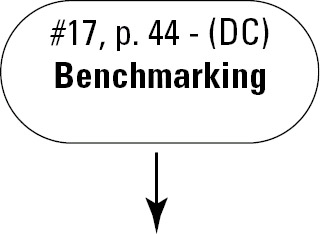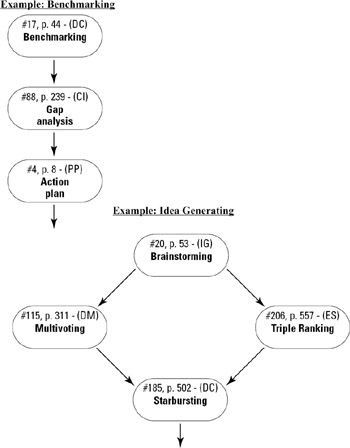Six Sigma Tools - Tools-Strings Examples
In an article authored by G.H. Watson[1], a point was made that in two separate ASQ studies (1996 & 1999) the evidence suggests that quality assurance professionals may slowly fade away if more tools were made available "to the masses." The Six Sigma Tool Navigator can certainly train the masses!
The new Six Sigma Tool Navigator reflects a great improvement since it now shows all 222 tools placed into easy to follow "Tool-Strings" flowcharts that sequence tools in the order of completion by a Six Sigma or any other team. This section was developed to fill a perceived need, which has been voiced frequently by the various teams utilizing the first edition Tool Navigator's 222 tools for problem solving, innovation and creativity, process/quality improvements, and other organizational change activities.
Although the Six Sigma Tool Navigator( displays a "Links to other Tools" feature for every tool, teams with little experience in linking tools to achieve a particular outcome have had some difficulties in determining what tools are appropriate for a particular task. In addition, teams often do not know the sequence in which these tools should be used. In order to respond to this need, the author has developed a set of 65 "Tools-Strings" or flowcharts of interconnected tools for teams. All 222 tools have been accounted for and are included in the many different flowcharts designed to provide the desired outcome.
At times, the same tools are called by different names. The following are a few examples:
-
"SIPOC" is shown as tool #195, "Systems Analysis Diagram"
-
"Quality Function Deployment" is shown as tool #91, "House of Quality"
-
"Kano" model is shown as tool #55, "Customer-First Question" (CFQ)
-
"Process Capability" is shown as tool #147, "Process Capability Ratios"
-
"Voice of the Customer (VOC) is shown as tool #53, "Customer Needs Table"
-
"Simple Linear Regression" is shown as tool # 43, "Correlation Analysis"
Since the above examples indicate the difficulty in selecting a tool by name or specific functionality, three reference aids are available in the Six Sigma Tool Navigator book:
-
A Cross Reference Index that lists 396 tool names in an alphabetical order. Since many tools are known by different names, this cross-reference will direct the team to the appropriate tool described in the Six Sigma Tool Navigator.
-
A Process Category Index that classifies all tools into the following eight (8) categories:
TB — Team Building
ES — Evaluating/Selecting
IG — Idea Generating
DM — Decision Making
DC — Data Collecting
PP — Planning/Presenting
AT — Analyzing/Trending
CI - Changing/Implementing
-
A Six Sigma DFSS and PFSS Tools Listing that further suggests what tools are frequently worked through in these Six Sigma projects.
The "Tools-Strings" flowcharts are typically drawn as shown in the examples below. The team works through the linked tools, follows the arrows, and refers to the Six Sigma Tool Navigator( for helpful information. Many flowcharts show the "OR" function, which allows the team to examine the tools and choose the correct tool to complete the process. Each flowchart box contains the following information:

-
#17 - The number of the tool (range 1—222)
-
p.44 - The page number for this tool in the Tool Navigator( book
-
DC - The tool's category, Data Collection (8 categories - see above listing)
-
The tool's name as used in the Tool Navigator( book

[1]Watson, G.H. "Bringing quality to the masses; the miracle of loaves and fish," Quality Progress, June 1998.
EAN: 2147483647
Pages: 326